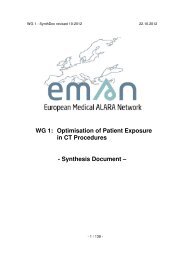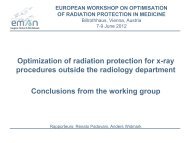Radiation Protection for Radiotherapy - E. Aird (ESTRO) - European ...
Radiation Protection for Radiotherapy - E. Aird (ESTRO) - European ...
Radiation Protection for Radiotherapy - E. Aird (ESTRO) - European ...
Create successful ePaper yourself
Turn your PDF publications into a flip-book with our unique Google optimized e-Paper software.
<strong>ESTRO</strong> Activities: <strong>Radiation</strong><br />
<strong>Protection</strong> <strong>for</strong> <strong>Radiotherapy</strong><br />
Edwin <strong>Aird</strong><br />
RPA/<strong>ESTRO</strong> Teacher
<strong>ESTRO</strong> Mission ( education)<br />
• The <strong>ESTRO</strong> School of <strong>Radiotherapy</strong> and<br />
Oncology is an international school that aims to<br />
improve, professionalise and standardise<br />
knowledge and practice in radiation oncology<br />
and associated professions in Europe and<br />
beyond. Our guiding principles are set out in our<br />
mission statement which was approved by the<br />
<strong>ESTRO</strong> Board on 14th September, 2008<br />
• To organise courses; workshops; large scientific<br />
meetings (all professions and researchers)<br />
together with the manufacturers.
801<br />
958<br />
1199<br />
1149<br />
1138<br />
1434<br />
1826<br />
1976<br />
2611<br />
2745<br />
2836<br />
2843<br />
Recent <strong>ESTRO</strong> Activity<br />
NUMBER OF COURSES AND PARTICIPANTS<br />
2000-2011<br />
Courses<br />
Participants<br />
1<br />
0<br />
1<br />
3<br />
1<br />
2<br />
1<br />
1<br />
1<br />
2<br />
1<br />
4<br />
1<br />
6<br />
1<br />
9<br />
2<br />
3<br />
2<br />
8<br />
3<br />
0<br />
3<br />
1<br />
2000 2001 2002 2003 2004 2005 2006 2007 2008 2009 2010 2011
<strong>ESTRO</strong> LIVE COURSES:<br />
ROADMAP
Aim of <strong>Radiotherapy</strong> (and the meaning of<br />
radiation protection in <strong>Radiotherapy</strong>)<br />
• To sterilise the tumour (e.g 74Gy)with<br />
minimum damage to the surrounding<br />
normal tissues and critical structures<br />
• Best practice requires: optimal planning in<br />
3D on CT; dose prescription includes<br />
dose/fraction and overall time AND critical<br />
structure tolerances (dose/volume criteria);<br />
full reporting of all these factors (ICRU 50<br />
ICRU 62; ICRU ## etc)
TISSUE EFFECTS FOR<br />
RADIOTHERAPY: Tumour Control<br />
Probability can increase without<br />
increasing NTCP if CTV-PTV<br />
margins are reduced<br />
Dose<br />
Escalation<br />
Moves to the<br />
right as<br />
margin<br />
reduced
ICRU volumes<br />
<strong>for</strong> Breast<br />
Internal Target<br />
Volume
<strong>Radiotherapy</strong> Process<br />
• Pre-planning diagnostic images<br />
• Planning Images: CT/MRI/PET/US etc<br />
• Transfer of 3D Patient Image to Treatment<br />
Planning System<br />
• Planning: 3D Con<strong>for</strong>mal; IMRT etc<br />
• Transfer actual patient to linac (or other) and<br />
correctly and accurately position<br />
• Verification Radiographs/CBCT<br />
• Treat/Follow-up
General Knowledge <strong>for</strong> R/T<br />
• Physics of the atom<br />
• Sources: High Energy 6-20MV + Diagnostic; Sealed and<br />
unsealed sources (e.g. Ir-192; I-125; I-131)<br />
• <strong>Radiation</strong> Physics<br />
– Interaction; geometry of beams etc<br />
• Radiobiology<br />
– Time/dose/fractionation; models etc<br />
• Concomitant Imaging <strong>for</strong> <strong>Radiotherapy</strong> ([For Image<br />
Guided <strong>Radiotherapy</strong> (IGRT)]<br />
• Second Cancer: imaging doses and out-of-beam doses<br />
• <strong>Protection</strong> Legislation
Modern Linac with the addition of kV<br />
On-Board-Imaging (Includes CBCT)
100000<br />
Dose in<br />
mGy<br />
10000<br />
Rectum<br />
Bone-<br />
Marrow<br />
R/T doses (mGy)<br />
<strong>for</strong> Prostate 74Gy<br />
(15MV) vs distance<br />
ALLEGRO<br />
EU Project<br />
1000<br />
100<br />
Colon<br />
Stomach<br />
Lung<br />
CT doses<br />
<strong>for</strong> daily<br />
CBCT<br />
R/T<br />
C/T<br />
Liver<br />
10<br />
Thyroid<br />
1<br />
0 20 40 60 80<br />
Distance<br />
Distance cm<br />
from centre<br />
from of fields centre
<strong>ESTRO</strong> and <strong>European</strong> Curricula<br />
<strong>European</strong> Core Curricula have been developed <strong>for</strong> the training<br />
of medical specialists in radiotherapy (radiation oncology),<br />
medical physicists in the field of radiotherapy<br />
and radiotherapy technologists.<br />
In 2002, these were endorsed by representatives<br />
from 35 <strong>European</strong> countries. In 2008 the school was created<br />
to bring together the established teaching<br />
Courses into a coherent structure. In 2011 the 3 Core Curricula<br />
have been updated
Basic Science <strong>for</strong> Oncologists (Part of<br />
<strong>ESTRO</strong> Core Curricula)<br />
• Radiobiology:<br />
– Describes the interaction of radiation on molecular<br />
level (knowledge)<br />
– Discusses DNA damage (comprehension)<br />
– Describes cellular effects, mechanisms of cell death<br />
(knowledge)<br />
– Describes repair of radiation damage (knowledge)<br />
– Discusses cell survival curves (comprehension)<br />
– Describes normal tissue systems (knowledge)
Basic Sciences (oncologists)<br />
• Basic radiation physics<br />
– Describes atomic and nuclear structure<br />
(knowledge)<br />
– Describes radioactive decay (knowledge)<br />
– Contrasts the properties of particle and<br />
electromagnetic radiation (analysis)<br />
– Defines and describes radioisotopes<br />
(knowledge)
Eg Part of <strong>ESTRO</strong> Training Course<br />
• Physics of teletherapy beams:<br />
– Energy of X-ray beams<br />
– Build-up and skin sparing<br />
– PDD and Isodose curves<br />
– Principles of wedges<br />
– Output factors<br />
– Beam geometry/penumbra etc
Isodoses<br />
• Depth dose penetrates further<br />
into tissue through thin end<br />
• Dynamic wedges give “pointier”<br />
isodoses<br />
• Slope reduces with depth due to<br />
scatter<br />
• Used in oblique incidence to<br />
shift isodoses by angle of<br />
incidence
Wedged pair<br />
• For head region<br />
• e.g. maxillary antrum or floor of the mouth<br />
• [NB What about Monitor Units?]
Treating the prostate ( 74Gy in 2Gy per#); avoiding rectum, bladder, etc
Isodose display - can be<br />
complex and 3D
Prostate Intensity Modulated RT plan,<br />
showing some reduction of rectal wall dose
Basic Sciences (oncologists)<br />
• Radioprotection<br />
– Discusses the general philosophy of radioprotection including<br />
ALARA (comprehension)<br />
– Contrasts stochastic and deterministic effects (analysis)<br />
– Discusses the risk of induction of secondary tumours<br />
(comprehension)<br />
– Defines and discusses radiation weighting factor (knowledge)<br />
– Defines and discusses equivalent dose – tissue weighting factor<br />
(comprehension)<br />
– Discusses occupational/public health consequences of radiation<br />
exposure, radioprotection and dose<br />
– limits <strong>for</strong> occupational and public exposure (comprehension)<br />
– Outlines <strong>European</strong> and national legislation (knowledge)<br />
– Determines what is evidence based in radioprotection<br />
(knowledge
Cyberknife<br />
Robotic<br />
<strong>Radiotherapy</strong><br />
using 6MV x-<br />
rays<br />
<strong>ESTRO</strong> Physics 2007<br />
<strong>ESTRO</strong> Physics 2007
Aspects of <strong>Radiation</strong> protection <strong>for</strong><br />
<strong>Radiotherapy</strong><br />
• Room Design; staff protection only <strong>for</strong><br />
sealed and unsealed sources<br />
• Second Cancer<br />
• Quality Assurance:<br />
– Definitions: QA, QC , QM, QS<br />
– Verification<br />
– Reporting Near misses and errors<br />
– What’s in a prescription…link to legislation
<strong>ESTRO</strong> Ref<br />
• The updated <strong>ESTRO</strong> core curricula 2011 <strong>for</strong> clinicians, medical<br />
physicists and RTTs in radiotherapy/radiation oncology JG Eriksen<br />
et al <strong>Radiotherapy</strong> & Oncology 103, 103-108 (2012)<br />
• Competencies in radiation oncology: A new approach <strong>for</strong> education<br />
and training of professionals <strong>for</strong> radiiotherapy and oncology in<br />
Europe R Potter et al <strong>Radiotherapy</strong> & Oncology 103, 1-4 (2012)<br />
• Shaping the future; training of professionals <strong>for</strong> radiotherapy in<br />
Europe M Baumann et al <strong>Radiotherapy</strong> & Oncology 70, 103 (2004)<br />
• Guidelines <strong>for</strong> the infrastructure of training institutes and teaching<br />
departments <strong>for</strong> radiotherapy in Europe E Rottinger et al Radio &<br />
Oncol 70, 123 (2004)
<strong>ESTRO</strong><br />
• <strong>ESTRO</strong> e-learning: EAGLE: <strong>ESTRO</strong><br />
Application <strong>for</strong> Global Learning<br />
• <strong>ESTRO</strong> web education:<br />
• http://www.estro-education.org
<strong>Protection</strong> <strong>for</strong> Brachy HDR<br />
• Well designed room ( which includes antiterrorist<br />
measures) +room GM tube<br />
• Calibration of new source (well chamber)<br />
• Emergency procedures ( especially if<br />
source sticks in patient)<br />
• Security (Environment Agency/Anti-Terror)<br />
• Quality Assurance: daily checks
HDR room design (example)
Layout example
<strong>Radiation</strong> <strong>Protection</strong> (<strong>ESTRO</strong> Physicists)<br />
– They have to be prepared to address the needs of<br />
protecting the patient, personnel and the general<br />
public in the radiotherapy department.<br />
– They have to know the physical and biological effects<br />
of radiation <strong>for</strong> exposed individuals, the relevant<br />
regulations, methods of compliance and record<br />
keeping.<br />
– This knowledge will allow them to assess the<br />
radiation risk and optimise the medical exposures.<br />
– They will be asked to apply the ALARA and dose<br />
limitation principles in the design of radiation therapy<br />
facilities, treatment and imaging protocols.
<strong>Radiation</strong> <strong>Protection</strong> <strong>for</strong> Physicists<br />
• Competences<br />
• • demonstrate an understanding of the principles of radiation safety procedures;<br />
• • ability to measure effective per<strong>for</strong>mance of radiation safety procedures;<br />
• • ability to improve effective per<strong>for</strong>mance of radiation safety procedures;<br />
• • ability to investigate and assess risk factors of radiation;<br />
• • ability to optimise medical exposures;<br />
• • ability to verify that the clinical physics program is in compliance with applicable<br />
national radiation safety regulations (e.g., radioactive materials licenses, occupational<br />
dose limits, and review of radiation surveys <strong>for</strong> any new construction);<br />
• • ability to per<strong>for</strong>m radiation surveys of an area using appropriate dose-rate meters<br />
• • ability to per<strong>for</strong>m design calculations <strong>for</strong> a linac room, simulator/CT room,<br />
brachytherapy source room;<br />
• • ability to discuss the use of personal dosimeters;<br />
• • ability to prepare the documentation needed <strong>for</strong> audits by the radiation protection<br />
authorities;
Basic Sciences (oncologists)<br />
• <strong>Radiation</strong> physics applied in radiation therapy (RT)<br />
• Outlines the design and explains the mechanism of action of an X-<br />
ray tube (comprehension)<br />
• Describes the design and explains the mechanism of action of a<br />
linear accelerators<br />
• (comprehension)<br />
• Describes specialized collimating systems (knowledge)<br />
• Describes brachytherapy systems (knowledge)<br />
• Outlines the design and explains the mechanism of action of a<br />
cyclotron (comprehension)<br />
• Defines, explains and discusses absorbed dose distributions<br />
(comprehension)<br />
• Describes treatment planning including 3D planning, virtual and CT<br />
simulation and applies these<br />
• procedures to plan patients’ treatments (application






